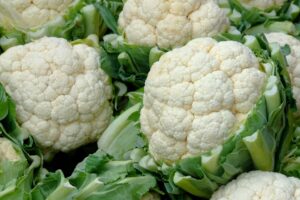Cauliflower, the versatile cruciferous vegetable, has found its home in the diverse agricultural landscape of South Africa. Known for its nutritious properties and culinary flexibility, cauliflower has become a staple in South African cuisine. In this article, we will explore the fascinating world of cauliflower cultivation in South Africa, including ideal planting and harvesting times, and the provinces where this cruciferous delight thrives.

Cauliflower: A Culinary Marvel
Cauliflower, scientifically known as Brassica oleracea var. botrytis, is a member of the Brassicaceae family. This vegetable is revered for its high nutritional value, boasting an abundance of vitamins, minerals, and antioxidants. South Africa’s favorable climate and fertile soil provide an ideal environment for cultivating this nutritious vegetable.
When to Plant Cauliflower
Cauliflower is a cool-season crop, thriving in moderate temperatures. In South Africa, the planting season for cauliflower typically begins in late winter to early spring, around August to September. During this time, the weather is mild, with less extreme temperature fluctuations. Gardeners and farmers sow cauliflower seeds directly into well-prepared soil or transplant seedlings into the ground.
Ideal Growing Conditions
Cauliflower plants require specific growing conditions to flourish. They prefer well-drained soil rich in organic matter and a slightly acidic to neutral pH level. Adequate sunlight, typically around 6 hours of direct sunlight per day, is crucial for healthy cauliflower growth. Regular watering is essential to keep the soil consistently moist, ensuring proper development of the cauliflower heads.
When to Harvest Cauliflower
Cauliflower is ready for harvest approximately 60 to 80 days after planting, depending on the variety. The optimal time to harvest cauliflower is when the heads are firm, compact, and have a consistent creamy-white color. Waiting too long can result in overgrowth, causing the heads to become loose and grainy in texture. Harvesting is usually done in late autumn to early winter, around May to June in South Africa, before the onset of extreme cold weather.
Cauliflower Cultivation in South African Provinces
Western Cape

The Western Cape province, with its Mediterranean climate characterized by mild, wet winters and warm, dry summers, provides an excellent environment for cauliflower cultivation. The region’s well-drained soils and moderate temperatures support the growth of high-quality cauliflower. Farmers in this province often plant cauliflower in the winter months, ensuring a bountiful harvest in late spring.
Eastern Cape
The Eastern Cape province, known for its diverse agricultural activities, offers favorable conditions for cauliflower cultivation. With a temperate climate and reliable rainfall, this region allows farmers to grow cauliflower throughout the year. However, the optimal planting times align with the national trend, with cauliflower being planted in late winter and early spring.
Gauteng
Gauteng, the economic hub of South Africa, experiences a subtropical highland climate. While the province has warmer temperatures compared to other regions, cauliflower cultivation is still possible. Farmers in Gauteng typically plant cauliflower in late winter to early spring, ensuring that the crop matures before the summer heat intensifies. Proper irrigation is crucial in this province to compensate for occasional dry spells.
KwaZulu-Natal
KwaZulu-Natal, with its warm, subtropical climate and abundant rainfall, provides an ideal environment for cauliflower cultivation. The province’s farmers can plant cauliflower throughout the year, taking advantage of the consistent weather conditions. With careful management of water resources, KwaZulu-Natal yields a steady supply of high-quality cauliflower, making it an important contributor to the regional agricultural economy.

Limpopo
Limpopo province, characterized by hot summers and mild winters, presents unique challenges and opportunities for cauliflower cultivation. Farmers in this region strategically plan their planting schedules, avoiding the extreme heat of summer. By planting cauliflower in late winter or early spring, they capitalize on the milder temperatures and ensure a successful harvest. Adequate irrigation and soil preparation are crucial factors in Limpopo’s cauliflower farming practices.
Conclusion
Cauliflower cultivation in South Africa showcases the nation’s agricultural diversity and adaptability. With the right knowledge and careful planning, farmers across the provinces can harness the natural resources and favorable climates to produce abundant cauliflower crops. Whether enjoyed fresh, roasted, or incorporated into various dishes, cauliflower continues to be a beloved vegetable, enriching South African cuisine and contributing to the nation’s agricultural legacy. As South Africa’s agricultural landscape evolves, cauliflower remains a symbol of resilience and innovation in the face of changing climates and agricultural practices.
Author: Nicolene Oosthuizen

